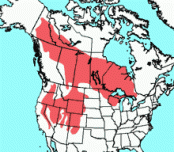Least Chipmunk
Tamias minimus
Description
The Least Chipmunk, Tamias minimus, is perfectly named! This is a very small chipmunk, weighing only 32 to 50 grams with a total length of 185-216 mm. The Least Chipmunk loves to use its tail and will run with the tail straight up and flicker it back and forth while perching.
Chipmunks can be distinguished from other squirrels by their distinct striping through the eyes. If the striping does not run all the way through the eyes, it is not a chipmunk. Many people confuse the golden-mantled ground squirrel with chipmunks because of the similar stripped pattern. In the eastern United States there is only one dominant species of chipmunk: the Eastern Chipmunk (Tamias striatus). But in the west, there are about 28 different and distinct species of chipmunk! It can be extremely hard to tell the difference, especially when these little critters are moving so fast. But there are subtle differences in color, stripe pattern, size, length, habitat choice, and range.
The Least Chipmunk, like other chipmunks, are diurnal and are active during the day and sleep in their burrows at night. In cold winter months, it will spend its days underground, periodically waking up to feed on stored food. Unlike the Eastern Chipmunk, the Least Chipmunk does not hibernate.
Habitat
The Least Chipmunk, one of the most widespread of all chipmunk species, is most abundantly found in alpine coniferous forests (cone-bearing trees) and tundra, but you may also find the it in aspen woodlands, chaparral scrub and sagebrush desert. Least Chipmunks are found in the western portion of the United States and throughout much of Canada.
Diet
The least chipmunk’s diet, as with most other chipmunks, consists primarily of nuts and seeds that they gather in their very large cheek pouches. But this littlest chipmunk will also eat leaves, grasses, flowers, insects, and fungi.
Ecological Importance
They scatter-hoard, storing seeds all over the place, so they unwittingly help many species of plants sprout in new places.
Related Topics
Description
The Least Chipmunk, Tamias minimus, is perfectly named! This is a very small chipmunk, weighing only 32 to 50 grams with a total length of 185-216 mm. The Least Chipmunk loves to use its tail and will run with the tail straight up and flicker it back and forth while perching.
Chipmunks can be distinguished from other squirrels by their distinct striping through the eyes. If the striping does not run all the way through the eyes, it is not a chipmunk. Many people confuse the golden-mantled ground squirrel with chipmunks because of the similar stripped pattern. In the eastern United States there is only one dominant species of chipmunk: the Eastern Chipmunk (Tamias striatus). But in the west, there are about 28 different and distinct species of chipmunk! It can be extremely hard to tell the difference, especially when these little critters are moving so fast. But there are subtle differences in color, stripe pattern, size, length, habitat choice, and range.
The Least Chipmunk, like other chipmunks, are diurnal and are active during the day and sleep in their burrows at night. In cold winter months, it will spend its days underground, periodically waking up to feed on stored food. Unlike the Eastern Chipmunk, the Least Chipmunk does not hibernate.
Habitat
The Least Chipmunk, one of the most widespread of all chipmunk species, is most abundantly found in alpine coniferous forests (cone-bearing trees) and tundra, but you may also find the it in aspen woodlands, chaparral scrub and sagebrush desert. Least Chipmunks are found in the western portion of the United States and throughout much of Canada.
Diet
The least chipmunk’s diet, as with most other chipmunks, consists primarily of nuts and seeds that they gather in their very large cheek pouches. But this littlest chipmunk will also eat leaves, grasses, flowers, insects, and fungi.
Ecological Importance
They scatter-hoard, storing seeds all over the place, so they unwittingly help many species of plants sprout in new places.

































































































